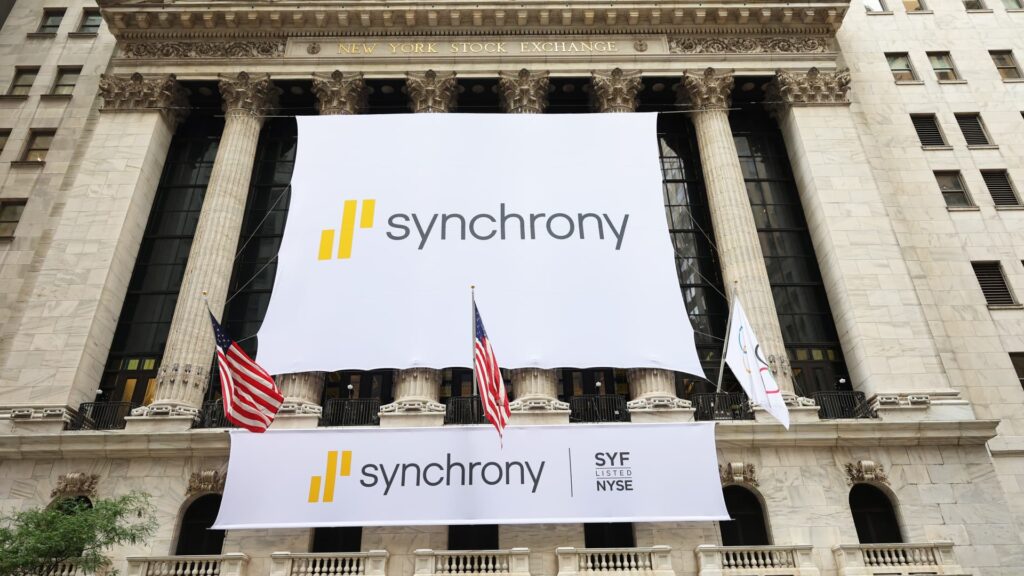
Banks keep high rates inspired by now-dead CFPB rule
Banks Maintain High Credit Card Rates Despite Death of CFPB Rule
Table of Contents
The New York Stock Exchange, where many credit card issuers are traded, as banks maintain high interest rates despite regulatory changes. (Image: Michael M. Santiago/Getty Images)
Credit Card Rates Remain at Record Highs
Banks and credit card issuers across the United States are maintaining high interest rates and fees that were initially implemented in response to a Consumer Financial Protection Bureau (CFPB) rule that has since been struck down. Despite the rule’s cancellation by a federal court last month, major financial institutions are showing reluctance to reverse the rate increases and fee additions they rushed to implement when the regulation threatened their revenue streams.
Store-branded credit cards, in particular, are continuing to charge record-high interest rates, with the average retail card APR hovering around 30.5% according to Bankrate surveys. This represents a stark increase from previous years and demonstrates the industry’s determination to preserve this newfound revenue, even after the regulatory threat has disappeared.
Key Facts: Credit Card Rates After CFPB Rule
- Retail credit cards hit record high average interest rates of 30.5% last year
- Rates have decreased by less than 1% since hitting their 2024 peak
- Store-branded cards typically charge about 10 percentage points higher than general-purpose cards
- Many issuers added new monthly fees for paper statements to offset potential revenue losses
- The CFPB rule that prompted these increases was struck down in April 2024
Two of the largest players in the store-branded credit card space, Synchrony Financial and Bread Financial, have explicitly stated they have no plans to reverse the changes they made in anticipation of the CFPB rule. These companies issue branded credit cards for major retailers including Amazon, Lowe’s, Wayfair, and many others.
The Death of the CFPB Late Fee Rule
The now-defunct CFPB regulation was designed to limit what Americans would pay in credit card late fees, which the agency under Director Rohit Chopra had characterized as excessive. The CFPB estimated that its rule would save American families approximately $10 billion annually by capping late fees at $8, significantly lower than the industry standard of approximately $30-40.
“We feel pretty comfortable that the rule has been vacated. With that said, we don’t currently have plans to roll anything back in terms of the changes that we made.”
This statement from Synchrony CEO Brian Doubles during an April 22nd earnings call encapsulates the industry’s stance. Similarly, Bread Financial CEO Ralph Andretta stated, “At this point, we’re not intending to roll back those changes, and we’ve talked to the partners about that.”
Banking industry trade groups successfully challenged the CFPB rule in federal court, arguing it represented regulatory overreach. However, the preemptive moves made by credit card issuers to protect their revenue streams have now become permanent fixtures of the lending landscape, creating what critics describe as an unintended windfall for the industry at consumers’ expense.
The Disproportionate Impact on Store Card Users
The persistence of high interest rates is particularly consequential for users of store-branded credit cards, who often have different demographic and financial profiles than users of general-purpose cards from issuers like Chase or American Express. According to CFPB data, nearly half of all retail card applications are submitted by people with subprime credit scores or no credit history at all.
Who Uses Store Credit Cards?
- Nearly 50% of applicants have subprime credit scores or no credit history
- Approval rates are higher than for general-purpose cards
- Many users lack access to traditional banking products
- Store cards often serve as entry points to credit for newer consumers
- Card users may have fewer alternatives due to limited credit options
Ted Rossman, a senior analyst at Bankrate, noted that companies like Synchrony and Bread Financial “rely a lot more on people who carry balances or who pay late fees.” This business model creates vulnerability for consumers who may have fewer financial options and less ability to shop around for better terms.
There were more than 160 million open retail card accounts in the United States last year, according to CFPB data, representing a significant segment of the credit market that disproportionately serves financially vulnerable Americans.
Bank Profits Soar as Consumers Pay More
The financial impact of maintaining these elevated rates has been significant for the issuing banks. Both Synchrony and Bread Financial reported first-quarter profits that easily exceeded analyst expectations, leading to upward revisions in earnings estimates for the year despite broader concerns about an economic slowdown.
“The companies have made a windfall,” observed David Silberman, a veteran banking attorney who lectures at Yale Law School. “They didn’t think they needed this revenue before except for [the CFPB rule], and they’re now keeping it, which is coming directly out of the consumer’s pocket.”
| Credit Card Issuer | Typical APR Before CFPB Rule | Current APR | Change |
|---|---|---|---|
| Average Retail Card | 26.72% | 30.5% | +3.78% |
| Macy’s Card (Citigroup) | 29.99% | 33.49% | +3.5% |
| Amazon Store Card (Synchrony) | 27.74% | 31.99% | +4.25% |
| General Purpose Cards (Average) | 19.07% | 20.39% | +1.32% |
The Retail Credit Card Market Landscape
Store-branded credit cards represent a crucial profit center not only for the issuing banks but also for the retailers themselves. According to the CFPB, more than half of the 100 largest U.S. retailers offer store cards, with brands like Nordstrom and Macy’s relying on them to generate approximately 8% of their gross profits in recent years.
This symbiotic relationship between retailers and card issuers creates strong incentives to maintain the high-rate environment, as both parties benefit from the revenue generated through interest payments and fees. For retailers, these cards not only provide a direct profit stream but also foster customer loyalty and increase average transaction sizes.
Retail Card Industry Structure
The retail credit card ecosystem involves multiple players:
- Issuing Banks: Financial institutions like Synchrony, Bread Financial, Citigroup, and Barclays that provide the actual credit
- Retailers: Brands that partner with banks to offer co-branded cards, receiving a portion of the revenue
- Processors: Companies that handle transaction processing and technology infrastructure
- Consumers: End users who receive store-specific benefits but often pay higher rates
- Regulators: Agencies like the CFPB that attempt to provide oversight of the industry
Major players like Citigroup and Barclays, which also maintain significant presences in the retail card space, have similarly shown no indication of rolling back their rate increases. The most recent published APR on the Macy’s card, issued by Citigroup, remains at 33.49%, exemplifying the industry-wide trend of maintaining elevated rates.
How Consumers Fall Into Retail Card Traps
Synchrony’s CEO Brian Doubles provided insight into why banks feel comfortable maintaining these high rates, noting that when they implemented the increases, “We didn’t see a big reduction in accounts or spend related to the actions we took. We did a lot of test and control around that.”
This consumer inertia helps explain the industry’s reluctance to reverse course. Retail cards are typically marketed at point-of-sale locations or through online checkout processes, often with promotional offers like “10% off your purchase today” or special financing terms. These immediate incentives can overshadow the long-term costs of high interest rates.
Common Retail Card Marketing Tactics
- Immediate discount on first purchase (typically 10-20%)
- “Special financing” offers with deferred interest clauses
- Exclusive access to sales and promotions
- Rewards points that can only be redeemed at the issuing retailer
- Priority customer service or extended return periods
- Point-of-sale application process with instant approval decisions
Consumer advocates have long criticized these marketing practices, which emphasize short-term benefits while downplaying the potential long-term costs. The high interest rates become particularly problematic when consumers carry balances month-to-month, as the compounding interest can quickly overwhelm the initial savings from promotional offers.
Financial Impact on Vulnerable Consumers
The maintenance of high interest rates on retail cards has tangible consequences for consumers, particularly those with limited financial resources. Alaina Fingal, a New Orleans-based financial coach, reported that she frequently works with clients who have fallen into debt spirals from using retail credit cards.
“They do not understand the terms, and there are a lot of promotional offers that may have deferred interest clauses that are in there,” Fingal explained. “It’s extremely predatory.” Some of her clients have had to take on additional employment, such as driving for food delivery services, to manage the debt they’ve accumulated.
Warning Signs of Retail Card Debt Problems
- Making only minimum payments on high-interest store cards
- Opening multiple retail cards for one-time discounts
- Not fully understanding promotional terms, especially deferred interest
- Using one card to pay off another
- Approaching credit limits on multiple accounts
- Struggling to keep track of multiple payment due dates
While Synchrony has indicated it might consider enhancing promotional offers with specific retail partners, the company has given no indication that it plans to reduce the baseline interest rates that generate significant revenue. In a statement, Synchrony said, “Our goal remains to provide access to financial solutions that provide flexibility, utility, and meaningful value to the diverse range of customers, partners, providers, and small and midsized businesses we serve.”
For consumers carrying balances on these high-interest retail cards, the failed CFPB regulation has had the unintended consequence of making their financial situations more precarious rather than providing the relief it was designed to deliver. As banks continue to benefit from the increased revenue, advocates are calling for greater transparency in marketing practices and improved financial education to help consumers understand the true costs of these credit products.






